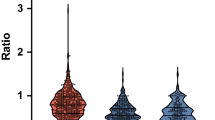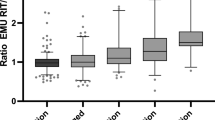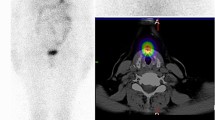Abstract
Background:
In Sweden, iodine has been added to table salt (10 mg/kg) since 1936; this amount was increased in 1966 to 50 mg/kg.
Objective:
To investigate a euthyroid Swedish population (n=44, 60–65 years) with its entire lifespan with iodine supplementation as for 24-h 131-I uptake (24h IU) and thyroid nodularity (thyroid scintigraphy). To compare the euthyroid 24h IU with uptake of thyrotoxic individuals, and with observations from 1955.
Methods:
The 24h IU was used in euthyroid individuals after oral administration of 0.1 MBq/2.7 μCi radioiodine and imaging of the thyroid gland was carried out using 99mTc-pertechnetate.
Results:
In 1999–2000, the mean 24h IU in the euthyroid individuals was 21% (range 11–33%) and the normal (central 95%) reference interval was 14–30%. Scintigraphy suggested multinodular goitre in three euthyroid individuals. In Graves' patients (n=53, 50–65 years), the mean 24h IU was 61% (range 29–89%). In 1955, the 24h IU in euthyroid individuals was higher (38%, range 10–70%), while hyperthyroid patients had uptake values similar to those recorded in the present investigation (mean 62%, range 40–90%).
Conclusions:
The population sample studied had to be small for ethical reasons. We conclude that the reference interval for 24h IU is 14–30% in this population that had spent its entire lifespan with iodine supplementation. This is lower than that recorded in a Swedish euthyroid population half a century ago having had low-grade table-salt iodine supplementation for 20 years. Values for hyperthyroid patients, however, do not appear to have been affected likewise.
This is a preview of subscription content, access via your institution
Access options
Subscribe to this journal
Receive 12 print issues and online access
$259.00 per year
only $21.58 per issue
Buy this article
- Purchase on Springer Link
- Instant access to full article PDF
Prices may be subject to local taxes which are calculated during checkout

Similar content being viewed by others
References
Arger PH, Jennings AS, Gordon LF, Coleman BG, Axel L, Kressel HY et al. (1985). Computed tomography findings in clinically normal and abnormal thyroid patients. J Comput Tomogr 9, 111–117.
Berg GE, Michanek AM, Holmberg EC, Fink M (1996). Iodine-131: treatment of hyperthyroidism; significance of effective half-life measurements. J Nucl Med 37, 228–232.
Hooper PL, Caplan RH (1977). The thyroid uptake of radioactive iodine in hyperthyroidism. JAMA 238, 411–413.
Kungliga Medicinalstyrelsen (1936). Förebyggande åtgärder mot endemisk struma. Medicinalväsendet 30, (in Swedish).
Kungliga Medicinalstyrelsen (1966). Jodering av koksalt. Medicinalväsendet 11, (in Swedish).
Larsson LG (1955). Studies on radioiodine treatment of thyrotoxicosis with special reference to the behaviour of the radioidine tracer tests. Acta Radiol, suppl 126 (Suppl), 5–164.
Milakovic M, Berg G, Nyström E, Lindstedt G, Gebre-Medhin M, Eggertsen R (2004). Urinary iodine excretion and thyroid volume in a Swedish population. J Int Med 255, 610–614.
Pitttman Jr JA, Dailey III GE, Beschi RJ (1969). Changing normal values for thyroidal radioidine uptake. N Engl J Med 280, 1431–1434.
Zvonova IA (1989). Dietary intake of stable and some aspects of radioiodine dosimetry. Health Physics 57, 471–475.
Acknowledgements
We thank Agneta Lundström for technical assistance. We wish to express our gratitude to Professor emeritus Lars-Gunnar Larsson for kindly giving us access to his data from 1955. We acknowledge the valuable help of Professor emeritus Göran Lindstedt in interpreting data from the reference population. The King Gustav V Jubilee Clinic Cancer Research Foundation, Göteborg, supported this study.
Author information
Authors and Affiliations
Corresponding author
Additional information
Guarantor: M Milakovic.
Contributors: MM collected data from the uptake measurements and compared the data with previous studies, GB was responsible for the nuclear medicine investigations and radiation aspects, RE was responsible for the establishment of the Mölnlycke population studies and mainly responsible for the contact with participants and, EN was responsible for endocrine and statistical aspects of the study. All authors contributed to the analysis and interpretation of data, and the preparation of the manuscript.
Rights and permissions
About this article
Cite this article
Milakovic, M., Berg, G., Eggertsen, R. et al. Effect of lifelong iodine supplementation on thyroid 131-I uptake: a decrease in uptake in euthyroid but not hyperthyroid individuals compared to observations 50 years ago. Eur J Clin Nutr 60, 210–213 (2006). https://doi.org/10.1038/sj.ejcn.1602290
Received:
Revised:
Accepted:
Published:
Issue Date:
DOI: https://doi.org/10.1038/sj.ejcn.1602290
Keywords
This article is cited by
-
Different novel biomarkers involved in diagnosing hypothyroidism
The Egyptian Journal of Internal Medicine (2023)



